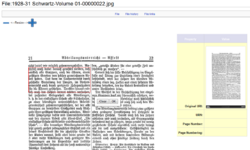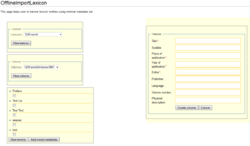Semantic CorA Extensions: Unterschied zwischen den Versionen
| Zeile 1: | Zeile 1: | ||
==Semantic Image Annotator== | ==Semantic Image Annotator== | ||
| − | [[ | + | [[File:SemImgAnn.png|right|thumb|250px|Semantic Image Annotator]] |
===Motivation=== | ===Motivation=== | ||
| Zeile 22: | Zeile 22: | ||
The development of the SemanticWebBrowser was carried out in cooperation with Benedikt Kämpgen and Semantic CorA served as a specific use case. | The development of the SemanticWebBrowser was carried out in cooperation with Benedikt Kämpgen and Semantic CorA served as a specific use case. | ||
==OfflineImportLexicon== | ==OfflineImportLexicon== | ||
| − | [[ | + | [[File:OIL.PNG|right|thumb|250px|OfflineImportLexicon]] |
===Motivation=== | ===Motivation=== | ||
To assist researchers in handling data which in the case of Semantic CorA were lexicon pages in the form of image files, a simplified and structured import-routine was needed. We developed an extension which supports this task and helps the researchers to import the bibliographic data of lexica and its image files in the developed data model based on four entities. | To assist researchers in handling data which in the case of Semantic CorA were lexicon pages in the form of image files, a simplified and structured import-routine was needed. We developed an extension which supports this task and helps the researchers to import the bibliographic data of lexica and its image files in the developed data model based on four entities. | ||
Version vom 10. März 2014, 18:02 Uhr
Semantic Image Annotator
Motivation
The annotation - also known as "coding" in the social sciences and humanities- of documents is a central activity in the research process. In our case, the lexica pages which have to be analyzed were in image format and not avaibale in plain text. Hence, the Semantic Image Annotator was developed which allows selection and annotation of rectangular areas on images.
Features
A button "Annotate this image" will appear above images on their "File:"-page. Clicking this button will activate the "annotation mode". You are then able to draw rectangular annotations on the image. Clicking once will start the shaping mode in which you can move your mouse to create any rectangular shape. Another click stops the shaping mode and you can decide to accept or discard the rectangle you have created. If you are happy with the shape of the selected area and click OK, a Semantic Forms popup window - with a form you can adjust - will appear. You can specify the details of your annotation in that window.
Links
For download and discussion: Official extension page at mediawiki.org
SemanticWebBrowser
Motivation
To browse beyond the own structured wiki content into the Semantic Web the SemanticWebBrowser (SWB) was developed. The SemanticWebBrowser allows to browse and compare the wiki's information with information from the Semantic Web. Our main motivation here was the enrichment of data in Semantic CorA with data from other resources (e.g. authority files of the German National Library, Gemeinsame Normdatei (GND)).
Features
The extension enables you to browse every article in your wiki in a structured way or to start browsing from any URI. If any equivalent URI is specified in the article, SWB loads and displays all the triples containing the URI as subject or object. For a full list of the features refer to the official extension page at mediawiki.org.
Links
For download and discussion: Official extension page at mediawiki.org
Acknowledgement
The development of the SemanticWebBrowser was carried out in cooperation with Benedikt Kämpgen and Semantic CorA served as a specific use case.
OfflineImportLexicon
Motivation
To assist researchers in handling data which in the case of Semantic CorA were lexicon pages in the form of image files, a simplified and structured import-routine was needed. We developed an extension which supports this task and helps the researchers to import the bibliographic data of lexica and its image files in the developed data model based on four entities.
Features
After successful installation, a user interface appears for the structured import. Following a hierarchical book structure, OfflineImportLexicon creates wiki pages for the four entities:
- Book (in our specific Use Case Lexicon)
- Volume
- Article (Lemma)
- Page as images
Links
For download and discussion: Official extension page at mediawiki.org


